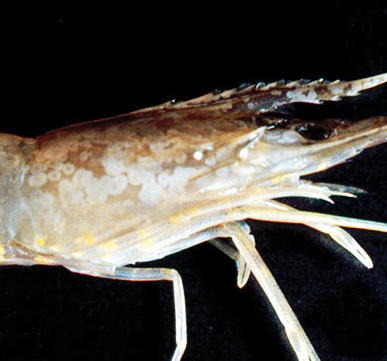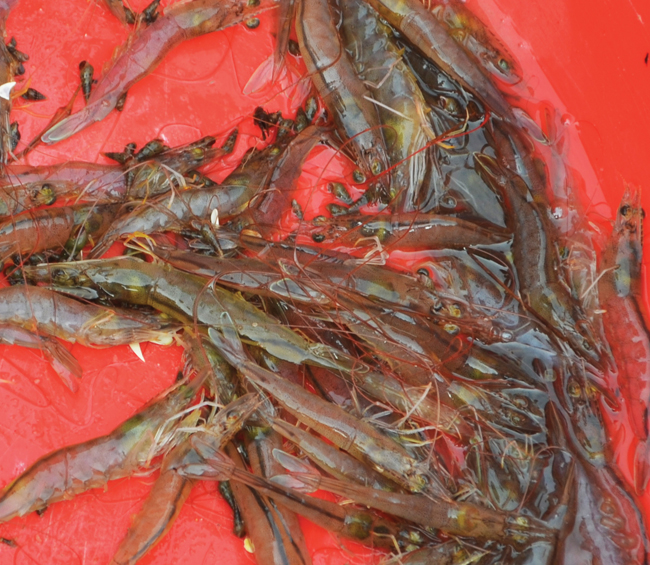Scourge below the surface
For shrimp and shrimp farmers, white spot syndrome virus is bad news.


Outbreaks of the virus can be economically devastating: It wreaked so much havoc in the Ecuadorian shrimp industry in 1999 that the country’s economy collapsed and the government was forced to adopt the U.S. dollar as the national currency in 2000.
The virus was first detected in Taiwan in 1992. From there, it spread throughout Asia, including India and the Middle East. It landed in the Americas in 1995, thought to be transported through frozen shrimp bait from Asia, at a south Texas shrimp farm. The virus has also appeared in Mozambique. The virus doesn’t infect only shrimp; other aquatic animals, such as crayfish, plankton and crabs, can carry the virus.
When shrimp get infected with WSSV, they develop visible white spots in their shells just before they die. Tools have been developed to detect the virus, which have helped to eliminate contaminated shrimp stocks. But lapses of oversight still occur, and outbreaks still happen. The problem is that once the virus infects shrimp there isn’t a way to treat the infection.

Mastering a new species
Until WSSV appeared, marine viruses were thought to be ecologically unimportant, because their types and numbers were underestimated. For this reason, marine viruses are less understood than other types.

WSSV is a new beast in terms of species: A new family (Nimaviridae) and genus (Whispovirus) had to be created just to accommodate it. Under the microscope, the virus resembles mammalian sperm, with a round head and a flexible tail.
The viral DNA was first isolated in 1997 and shown to be a double-stranded, circular molecule. By 2005, at least three different strains from various Asian locations had been sequenced. Genomic analyses have shown that “most of the approximately 180 genes included in the genome had unknown functions,” explains at the National Science and Technology Development Agency and Mahidol University in Thailand. “It is our belief that studying the functions of the mystery genes and understanding how they interact with host shrimp genes and even with each other will reveal new ways to combat the virus, in terms of both preventing infections and therapy after infection.
, Flegel, Chu-Fang Lo at the Cheng Kung University in Taiwan and colleagues described a proteomic analysis of WSSV in an effort to better understand how the virus functions and interacts with its host. The investigators used yeast two-hybrid screens to look at more than 700 possible interactions between about 180 proteins. To confirm that the interactions they saw were not experimental anomalies, the investigators then performed coimmunoprecipitation assays and other analyses.
Clinical signs

Thailand is the world’s leading exporter of shrimp. Over the past couple of years, it has been hit hard by yet another disease, known as early mortality syndrome, which has reduced significantly shrimp production in the region and has driven up global shrimp prices to a 12-year high in 2013. The cause of EMS recently was found to be bacterial.
|

Stephen G. Newman/AquaInTech Inc.
Whiteleg shrimp, also known as Pacific white shrimp, has gained in popularity over the past decade, in part because genetically screened, virus-free broodstock is available.

Stephen G. Newman/AquaInTech Inc.
Birds picking off infected shrimp.
|
Timeline
- 1992: Taiwan reports the first WSSV epidemic.
- 1993: The Chinese shrimping industry is crippled by it, and Japan and Korea have outbreaks.
- 1994: Thailand, India and Malaysia have outbreaks.
- 1995: WSSV is reported in the U.S.
- 1997: Viral DNA is isolated.
- 2005: Three strains have been sequenced.
- 2013: All shrimping regions have been affected.
This mapping of protein-protein interactions within a virus is a first for “a shrimp virus or virus of any other invertebrate,” says Flegel. Identifying hub proteins is important, because these proteins are thought to be central to various viral functions.
“This work clearly demonstrates the importance of several proteins for WSSV replication and disease progression and presents them appropriately as excellent future targets for antiviral therapy,” says Fraser Clark at University of Prince Edward Island in Canada, who is an expert in marine viruses but not involved with the research in the MCP paper. “These hub proteins could represent excellent targets for future antiviral therapy through interfering RNA, small-molecule inhibitors or antibodies capable of disrupting protein signaling.”
The next step, say Flegel and Clark, is to generate a protein-interaction map between WSSV and shrimp proteins.
“Many studies have shown the interaction of shrimp and WSSV proteins, but an extensive interaction map would demonstrate the importance of a subset of proteins that could be targeted for antiviral therapy,” explains Clark. “WSSV hub proteins are critical once infection has been established, but the disruption of the initial WSSV and shrimp protein interactions that facilitates infections could potentially prevent WSSV infections from becoming established in the first place.”

Editor’s note: Many thanks to Stephen G. Newman, marine microbiologist and president and chief executive officer of AquaInTech Inc., for his help with illustrating this article. AquaInTech, based in Lynnwood, Wash., supplies science-based products, tools and services to the international aquaculture community. Find out more at .
Enjoy reading ASBMB Today?
Become a member to receive the print edition four times a year and the digital edition weekly.
Learn moreGet the latest from ASBMB Today
Enter your email address, and weŌĆÖll send you a weekly email with recent articles, interviews and more.
Latest in Science
Science highlights or most popular articles

Guiding grocery carts to shape healthy habits
Robert ŌĆ£NateŌĆØ Helsley will receive the Walter A. Shaw Young Investigator in Lipid Research Award at the 2025 ASBMB Annual Meeting, April 12ŌĆō15 in Chicago.

Quantifying how proteins in microbe and host interact
ŌĆ£To develop better vaccines, we need new methods and a better understanding of the antibody responses that develop in immune individuals,ŌĆØ author Johan Malmström said.

Leading the charge for gender equity
Nicole Woitowich will receive the ASBMB Emerging Leadership Award at the 2025 ASBMB Annual meeting, April 12ŌĆō15 in Chicago.

CRISPR gene editing: Moving closer to home
With the first medical therapy approved, thereŌĆÖs a lot going on in the genome editing field, including the discovery of CRISPR-like DNA-snippers called Fanzors in an odd menagerie of eukaryotic critters.

Finding a missing piece for neurodegenerative disease research
Ursula Jakob and a team at the University of Michigan have found that the molecule polyphosphate could be what scientists call the ŌĆ£mystery densityŌĆØ inside fibrils associated with AlzheimerŌĆÖs, ParkinsonŌĆÖs and related conditions.

From the journals: JLR
Enzymes as a therapeutic target for liver disease. Role of AMPK in chronic liver disease Zebrafish as a model for retinal dysfunction. Read about the recent JLR papers on these topics.

